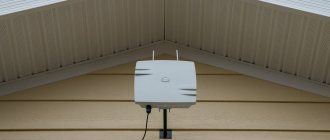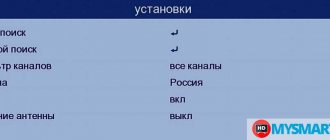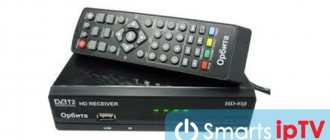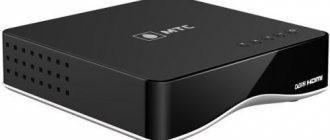It is impossible to imagine modern civilization without television; with its help, it is customary to find out the latest news in the country and the world, and, thanks to the many channels, you can brighten up your leisure time in the evening or on the weekend. But not all residents can afford to pay for high-definition channels and buy expensive equipment for digital television in the form of satellite dishes or cable wiring. This article discusses the methods that can be used to receive a digital signal, how to set up an antenna for a TV, and also describes the process of automatically and manually searching for channels on a regular receiver.
Digital channels via antenna
Types of signals from a television tower
Most large cities have their own system of television towers operating in a certain wavelength range that transmit the signal to consumers' televisions. This type of television is free, since you do not need to pay a monthly subscription fee to watch it, but the number of channels is limited. Depending on the type of signal, there are two types of television:
- Analog refers to signals that have a low frequency and are capable of carrying a limited amount of information. This type of signal has been used for a long time; most modern transmitters and televisions operate on it;
- Digital television. There are many more consumer channels here, most often commercial entertainment programs. Instead of an analog signal, in this case digital information of high definition and rich content is transmitted via frequency waves. As a result, the consumer receives an accurate picture with greater expansion.
It is worth noting! Unlike an analog signal, special equipment is required to transmit a digital signal, so the introduction of such technology and its replacement of outdated ones occurs gradually.
Now digital television, transmitted via an antenna, has gradually begun to replace analogue TV, as most of the channels are trying to switch to digital, and television receivers are more focused on this type of signal. Therefore, most likely, after some time, analog television will become obsolete and disappear completely.
Reason for mastering digital broadcasting
The digital signal is very stable. Ones and zeros are sometimes additionally encrypted with a code that is known to the recipient. Against a background of noise, the equipment scans the received signals; the correspondence of the sample to the incoming wave produces a peak that is many times higher than the noise level. Digital broadcasting will allow transmitter power to be reduced.
It is clear that in conditions of increased background electromagnetic radiation, quality is very important. This explains the obvious fact: digital television is gaining popularity.
Let's discuss quality separately. The encoded signal accurately conveys the colors of the pixels. The picture looks real; similar performance is difficult to achieve using analog transmission. Billions of colors can be recognized from the signal received by a digital television antenna. You may not notice the differences on the screen only because it is not profitable for free channels to increase the cost of equipment or buy double frequency bands in order to please the user with the Diamond Color shade presentation system.
Digital television has managed to narrow the signal spectrum. Let's discuss the physical meaning of the spectrum. The fact of conversion means: previously there were 10 analogue channels, now there will be approximately 35 standard definition digital channels.
There are three side properties that are useful to both sides of the client-provider connection:
- Protecting the channel from viewers who have delayed the subscription fee. A valuable advantage provided by digital television antennas. Look at what you need, cutting off what is unnecessary.
- Integration of broadcasting with the Internet. Now you can use special provider keys without purchasing additional equipment (receiver). The satellite access code is transmitted to the Internet network by the service provider's server. Usually there is a free test mode for viewing satellite digital television.
- We consider interactivity to be a novelty in video playback technologies. Live DVD Digital Options.
Digital TV antennas have a dozen advantages. If logical arguments do not convince you to choose digital, know that by 2015, 100% of broadcasting was planned to be digital.
Methods for receiving digital TV
What are the standards for electrical energy consumption for 2021 and 2018?
In order to connect digital TV, you can use two methods. First of all, this is a connection through a regional operator by connecting to a cable network. This method is quite simple and allows you to use a large number of entertainment and information channels, but you will have to pay a monthly subscription fee, which directly depends on the tariff and volume of programs.
TV reception methods
The second method is to use a household indoor or public antenna, as well as an amplifying receiver, which allows you to watch cable television, but in limited quantities. Every year, several channels are added to the list of channels available for free use, which can be received without a subscription fee, just catch the signal at the desired frequency. Most often, this method is used in remote regions, when there are no cable TV operators nearby, for which users point the indoor antenna towards the television tower and tune in television channels themselves.
How does digital work?
Digital television is streaming with the ability to broadcast channels on the same frequency. This is very convenient, as it helps solve a number of problems that arose in connection with analogue broadcasting:
- due to the fact that the channels are on the same frequency, quick tuning of the TV has become possible;
- lack of bureaucracy, since now each channel does not need to acquire a special license;
- repeaters are simpler in design than massive analog towers;
- a noticeable improvement in image quality and the absence of interference on the TV screen;
- switching from analog to digital is accessible and quite affordable;
- the image is available even with a weak signal.
The signal from the broadcasting station is transmitted using ground stations - repeaters. Each tower provides packet broadcasting of 10 channels, collected in a multiplex. The user just needs to buy an antenna that will pick up the required signal. If you are using an old TV, then you still need to purchase a set-top box for it, and newer models do not need such an addition, since they themselves are able to pick up a digital TV signal.
Terrestrial digital television is provided to users absolutely free of charge, without fees or monthly payments.
How to set up digital TV
Setting up an MTS satellite dish
To receive digital and analog television, dvb antennas are most often used, which can be installed outdoors or indoors. It is worth noting that this type of antenna has good signal reception characteristics only if it is positioned towards the television tower, so the most advantageous position for it is on the roof of a building or on its facade.
In order to configure analog and digital signals on a TV using the above antenna, you must follow the proposed algorithm:
- Determine the approximate location of the television broadcast tower. To do this, you can use a connected antenna, simply pointing it in different directions and monitoring the signal quality. You can also view these coordinates on the broadcaster’s website, which contains all the details of the nearest towers;
Antenna installation
- Installing the antenna on the base. To do this, it is necessary to fix the base in the form of a bracket or mast, onto which the device itself will subsequently be attached. The antenna is made of aluminum or copper tubes, so its weight is insignificant, and fixation can be carried out with simple metal clamps;
- A cable of a special configuration is laid from the receiving antenna to its power supply, which is located near the TV indoors. This product is designed only to transmit a digital or analogue television signal, as well as provide power to the antenna itself;
- Connecting the power supply to a 220 Volt network. Before applying energy, you must connect the carrier cable from the antenna to the amplifier, after which you can connect to the TV;
- The next step is to configure the channels transmitted by the television tower. To do this, there is no need to call a wizard, all actions can be performed independently; most TVs are equipped with automatic search, which, when the program starts, automatically finds all available channels. The setup can also be done manually; to do this, you need to enter the digital range from the table of channel providers;
- After the search has stopped, the TV will automatically remember all programs. You can change the channels yourself, arranging them in the desired order.
As you can see, the process of installing and configuring digital television is very simple, so any user can handle it.
Important! All work at height must be carried out using protective equipment and a safety rope.
TV tuner
Most modern TVs are equipped with a built-in tuner, which, when connected to an antenna, independently determines the channels available for viewing and remembers them. But there are times when there is no such device, then you can use a special antenna with an amplifier, which is marked dvb t2. Such a device, in addition to receiving equipment, includes a special device that amplifies the received digital signal and transmits it to the TV. In this case, this unit acts as a tuner; it has its own control panel, and tuning, as well as channel switching, occurs with its help. The main disadvantage of such a system is the number of devices included in its kit, as well as the method of operation, when you need to use two remote controls simultaneously.
DVB T2 device
How to connect a dvb t2 device? In this case, setting up the antenna is done using the same method as described earlier, the only difference is setting up the channels, when an amplifying device is used instead of a TV, and the connection is made with the same television cable.
Antennas
Antennas for digital television follow the requirements specified in the previous section. Models on sale:
- indoor;
- street;
- hybrid.
It is relatively easy to choose which antenna for digital television you will need. If the repeater is outside the window, then the indoor option is preferable. It is enough to buy a couple of meters of coaxial wire, and this will be enough to install the equipment. An indoor antenna is cheaper, equipped with a stand, and often the instructions allow it to be placed near a window.
Outdoor options are required where the signal is relatively weak. Reception on the roof will be incomparably better, and this fact can be used to enjoy digital broadcasting. I haven’t come across passive outdoor antennas, but if they exist in nature, it’s worth considering that the signal level at the TV input will greatly depend on the length of the cable. Those living on the second floor will most likely need an active antenna.
Hybrid options will allow you to install yourself both in the room and on the roof without compromising quality. Well, the price, of course, will be higher than that of a room apartment. When choosing equipment for signal reception, make sure that the antenna and broadcast ranges match. For information about the latter, please contact your digital television provider. They produce both varieties that cover entire channels and selective antennas.
NPP Ost produces a product that is attractive to Russians. Delta is an antenna for digital television, but searching for products through Yandex is a lost cause. The St. Petersburg manufacturer distributes products through dealers. And everything that the consumer needs is available.
Not only that, there are any designs on the counter in terms of installation locations, but the design also shines with variety. It is based on logarithmic and frame elements, but the external form is so amazing that you can visit the site if only to simply admire this magnificence. The wealth of engineering solutions is amazing. Unlike foreign products, which look the same.
Self-taught people chose the simplest method for making devices. The material chosen is coaxial cable. Use a TV with a characteristic impedance of 75 ohms. It is enough to ensure reliable reception of a single broadcast frequency. Muscovites have access to three multiplexes, the spectrum is constantly expanding.
Good luck! Read our reviews, watch digital television.
Analogue television is steadily losing its popularity. To ensure reception of a digital signal, first of all, you will need an antenna. When there is no desire or financial opportunity to get involved with the work of installing it on the roof, a digital indoor antenna comes to the rescue, which perfectly performs the main function of receiving a digital signal for little money.
List of available channels
Depending on the region, the program provider that broadcasts programs through the TV tower offers several packages in which TV channels are usually formed into groups of 20 pieces. Based on this classification, several blocks can be identified for which twenty channels are available.
Connecting an LED through a resistor and calculating it
The first multiplex of free channels that the dvb t 2 system is capable of receiving includes ten digital channels:
- First channel;
- Russia 1;
- TV Center;
- NTV;
- Russia Culture;
- Match TV;
- Carousel;
- Channel 5;
- OTR;
- Russia 24.
All of the listed channels are distributed on the waves of the 546 MHz C30 range, so during setup you must select the thirtieth level.
Digital channels received via a conventional antenna, according to the 2021 list, are available from the following list of the second category:
- REN TV;
- Saved;
- STS;
- Home;
- TV channel TV3;
- Sport plus;
- Star;
- World;
- TNT;
- Muz TV.
These television channels are received in the 498 MHz broadcast range at level 24, so you need to select this parameter on the set-top box during setup.
The third broadcast package includes ten more programs, including:
- Sports 1;
- My Planet, Science 2.0, Fight Club;
- History, Cartoon, Russian detective, Russian bestseller;
- Country, Sundress;
- Mom, 24 doc, Amusement Park;
- Euronews, Trust;
- Music of the first;
- A Minor, Kitchen TV, Auto Plus, India TV, HD Life;
- Life News;
- Our football.
These channels appeared relatively recently, so they are broadcast on a grid, depending on the time of day. The frequency for tuning the antenna is 578 C34; previously this channel was occupied by analogue programs, which are now outdated. Thus, using these lists, you can independently install a dvb t2 system and find the programs you are interested in.
Important! You need to use the antenna with extreme caution, since the slightest vibrations, especially of an indoor unit, can lead to signal loss and disruption to broadcasting.
TV tower
The quality and number of channels available for viewing directly depend on the type of transmitter and its distance. For example, in Moscow and the Moscow region, as well as in other large cities, the level of the digital television signal will be much better and stronger, since they have powerful emitters located on television towers. The further into the province the receiver is located, the worse the signal will be, therefore, a much more powerful amplifier will be needed.
It is worth noting! The quality of production of parts directly depends on the final cost, so there is no need to purchase an antenna at too low a price, since most likely its service life will be much shorter. It is better to buy a product from a manufacturer that enjoys authority in the market and has many positive reviews, most often these are domestic organizations.
Legends about miracle antennas
In order not to fall into the trap of unreliable information that has filled these Internets of yours, let us, dear anonymous, go through all sorts of myths, legends and other fakes wandering in the environment of amateur antenna construction. Our people, who don’t take a taxi to the bakery, have been building television antennas for a long time, so most of the myths apply specifically to them. Like any other, antenna myths are based on human ignorance, however, in the digital era, anonymous myths are more often found with unreliable advertisements from dubious antenna manufacturers or with viral videos on Yotrube, the main purpose of which is not to help in making a good antenna, but to increase the number of views. Those. in both cases they simply want to “make money” from us through direct deception...
Bearded myths
The most striking and famous is the legend of the “ Mercury Antenna ”. This legend is more than half a century old and is still alive. When the legend began his life's journey, mercury was used in radar stations. This caused an eerie creative surge in the anonymous person’s brain. Why is it there, if not to give super properties to the radar antenna?! The myth grew and developed, giving rise to subsidiary myths (about, for example), and the seething took place not only in kitchens and garages, but also resulted in serious publications on the pages of popular magazines. The second well-known ignorant myth is an antenna made from two beer cans , which must be attached to coat hangers. The myth is very popular; there are a lot of videos dedicated to it on YouTube. The famous video blogger, antenna-artilleryman Kreosan, did not ignore him either. But we won’t waste your time by analyzing outright fakes, but let’s review real antennas.
False advertising
“The antenna is covered with a special material to which radio waves stick.” Such openly delivering offers have almost disappeared from advertising texts, but this does not change the essence. The deception has simply become more subtle. They began to write mainly that they offer “the most powerful antenna, Vasya!” One of the most striking examples of such deception is the “Japanese” antenna HQClear TV . which can be found for sale in online stores. This is not the only example of a scam in the antenna field. They constantly appear under new “flashy” names. , the AERIAL 2100 antenna . To avoid becoming a victim of this kind of scam, it is not at all necessary to delve into the technical jungle, you just need to understand that miracles do not happen and a powerful antenna simply cannot be small in comparison with the wavelength. In addition, such antennas are most often sold exclusively on the Internet through fly-by-night online stores created specifically for the scam. If you are looking online for “the most powerful small indoor digital antenna,” then you will most likely come across similar traps for suckers in the first places. Just google the name of this “Japanese powerful antenna” and if you see the words “SCAM” in the results, you don’t even have to read about it further...
Technically incorrect decisions
Triple square
The anonymous person who came here is usually more technically savvy and wants to make an antenna with his own hands, however, he is not immune from unreliable or erroneous information. A striking example is the Triple Square . Sometimes you can find it on the Internet by the name of its popularizer, Sotnikov antenna . The myth about the enormous gain of this antenna (up to 15 dBd or 17 dBi) with very low hardware consumption has existed for decades. Previously published in serious magazines and books, he has now settled on the Internet and still lights the hearts of enthusiasts with fire. But this is just a myth based on incorrect theoretical premises, which is the topic of a separate large article to which I refer you: . In addition, the antenna is quite narrowband and is suitable for receiving only one, maximum two digital multiplexes, which is completely insufficient in our time.
People's UHF Z-antenna
Many myths have been revealed in the digital age with the advent of programs - electromagnetic simulators. Indeed, in the pre-digital era, the development of antennas required rather expensive and complex measurements on special stands in echo-free chambers. However, many designs that did not undergo this procedure became famous simply due to publications in popular publications. One of these antennas is the “people's UHF Z-antenna ,” drawings of which can often be found on the Internet and many people undertake to repeat it for receiving digital television. The description of the antenna originates in the brochure “To help the radio amateur” No. 94, page 68. However, as analysis shows, the input impedance of the antenna has a significant capacitive component, for this reason the SWR within the operating range is quite high and it cannot be recommended for receiving digital television :
It should be especially noted that the “people's UHF Z-antenna ” is not an optimized option. The optimal design is little known and is described on our website as a completely suitable antenna.
Nothing good can be said about most other similar “old-fashioned”, popular designs from old magazines. For example, a double triangular antenna , described in the book by G. I. Boriychuk and V. I. Bulych, “For a radio amateur about television antennas,” and then in the magazine Radio No. 6, 1998. A detailed description of this antenna with a calculation calculator can be found. An HFSS study of this design shows that the input impedance of this antenna has a significant reactive component, the SWR varies from 2.7 to 4.8, and the operating frequencies are actually located much higher than the calculator estimates. a UHF antenna made from coaxial cable, popular among DIYers . Although in reality it is in principle impossible to classify this design as an antenna, since the reduction feeder is directly involved in reception. But this doesn’t stop the craftsmen from YouTube. Moreover, some unique people connect it to the television socket with just the central wire, which is very satisfying. You, dear anonymous, are not from this cohort of advanced creatives, are you? At least I hope so. A detailed analysis of this antenna is available. As a result, we can come to the conclusion that old, seemingly time-tested designs need serious critical analysis and most of them are completely unsuitable for receiving digital television , at least in the case of long-range and unstable reception, which is what interests us in the first place . After all, there is a nail and an antenna near the TV tower.
Turkin antenna
However, if you initially specified incorrect technical requirements for the antenna, then even calculations in the simulator will not guarantee the desired final result. An example of this is the Turkin antenna , which has become quite popular on these Internets of yours. The famous radio amateur V. Polyakov optimized it in the MMANA simulator. From the perspective of a shortwave radio amateur, this is a fairly good antenna, but if you look at it from the perspective of a television antenna structure, it has a lot of serious shortcomings. Let's evaluate the characteristics of the optimized Turkin antenna, the dimensions of which are designed for a frequency of 600 MHz, over the entire UHF range:
- We see that the antenna is very narrow-band, almost single-channel, and “step to the left, step to the right” in frequency leads to an exorbitant increase in the SWR. Who guarantees you that birds, wind, snow, etc. will not push her to this step?
- The level of suppression of the rear lobe of the radiation pattern declared by the authors is not even close in the entire band.
- The antenna is very sensitive to the design of the connecting line between the active rings, which the authors prefer to keep silent about. A small change in the distance between the line wires leads to a large antenna mismatch.
- The presence of a ferrite ring on the feeder is clearly not enough for good balancing; it is advisable to use a full 1:1 balun, a quarter-wave cup, etc.
- Operating an antenna with an amplifier is almost guaranteed to lead to self-excitation of the latter.
The antenna has very poor repeatability and does not have any significant advantages. Gain does not exceed 11.5 dBi with precision manufacturing. And if you twist six rings crookedly onto a stick, you won’t get that either. But note, all this hemorrhage will give you the opportunity to take just one multiplex! Which, as we have already noted, is completely insufficient for DVB-T2. We strongly do not recommend the Turkin antenna for long-distance digital television reception . In any case, her characteristics are much worse than the well-known Polish woman. In addition, programs based on the NEC kernel (MMANA, 4NEC2) are not entirely suitable for calculating such antennas. In any case, when modeling a trunk line, it is almost impossible to get around the limitations of the NEC engine. That is why there are kinks in the graphs above. However, the conclusion regarding the suitability of this antenna does not negate this fact. You can look at the results of modeling the Turkin antenna in HFSS at the 4th link at the end of the article and see for yourself.
"Cool" appearance of the antenna
Often the main role in the popularity of a particular antenna is played by its unusual “cool” appearance. As an example, let's take the overseas popular antenna HD Frequency Cable Cutter . Many Americans actually make a terrible discovery for themselves that digital TV can be watched for free over the air using such a device. Considering that the average bill for cable television there is about $1,000 a year, and the device has a “cool” appearance, then it’s no wonder that it sells well. In reality, the antenna has a gain no greater than the usual Kharchenko zigzag, which is visible in its center, and there was no need to fence this entire lattice around. Well, perhaps only to make it easier to lure the hamster “to give away money” in the field of miracles, where he is offered a miracle device - a “ cable TV cutter ”. It should be noted that similar complex arrays do exist and are quite effective, but this is something that has nothing to do with this miracle antenna.
Another such “beautiful” type of antennas is Fractal antennas . At one time, they became a kind of fashion, a kind of antenna “nanotechnology”. Many businessmen even tried to make money from this fashion, and quite successfully. First of all, the inventor of fractal antennas himself, Nathan Cohen. Well, you got the hint! However, gradually, somehow quietly, all this noise goes away. Most of the serious companies professionally involved in antenna design have never even dealt with fractals. Why? The answer is obvious. Fractal antennas do not have any advantages over linear ones. If you conduct research on fractal antennas in an electromagnetic simulator, you can come to the following conclusions:
- If the dimensions of the fractal elements are much smaller than the wavelength, and the dimensions of the fractal figure itself are multiples of a half-wave, then it simply reduces to some simple and well-known canonical form (dipole, monopole, conical dipole-butterfly, patch). At the same time, the canonical butterfly dipole in this case looks beautifully “perforated” according to the fractal pattern. With the same success, it can be perforated in the form of a Repin painting and it will look even more beautiful. This perforation practically does not affect its characteristics as an antenna.
- If the dimensions of the fractal elements are comparable to the wavelength (most often found in images), then it becomes equivalent to a shortened (collapsed) dipole (monopole, butterfly). This is exactly the kind of antenna that was first proposed by Nathan Cohen as a fractal antenna. But like any shortened dipole, such an antenna has a low radiation resistance value, and, as a result, reduced efficiency. Therefore, apart from “beautifulness” and reduced dimensions, the fractal in this case has no other advantages over canonical vibrators. This also includes the Sierpinski triangle. In essence, this is a perforated butterfly monopole with reduced radiation resistance at the operating frequency.
- It is possible that its structure is similar to a typical fractal, but has nothing to do with the principle. It's like the exception that confirms the rule.
- In the limiting case, such combinations of fractal configurations are possible when the radiation of its individual elements occurs in antiphase and completely compensate each other. The radiation resistance of such a design tends to zero and it can no longer be called an antenna. This is already something like a high-quality cavity resonator.
Conclusion. Fractalization does not have any positive effect. From the point of view of antenna theory, this is simply decorative “cross stitch”. Depending on the embroiderer’s imagination, you can end up with either a full-fledged antenna, a shortened antenna, or simply a cavity resonator. The laws of physics cannot be fooled. After all, the polarization of an electromagnetic wave is linear, why does such a wave need beautiful embroidery?
Related links:
- — analysis in HFSS.
- Wideband Kharchenko antenna for digital television.
- Kharchenko's double zigzag for digital television.
- VK()
- Facebook()
- Comments (6)
Comments
KonstantinZ 08/09/2019 14:53 I won’t argue - I don’t have enough qualifications, but I have experience. When the UHF was first introduced, the power of the transmitters was calculated in watts; I had to try a lot both myself and my friends. In short, the most difficult case. 20 km to the transmitter antenna, an obstacle in the form of a reinforced concrete building, nowhere to catch reflexes. R (rumored) 5W. We tried: 1) factory Yaga with 3 directors, homemade Yaga - mop, Kharchenko, Kharchenko with ears. In addition to the factory one and the mop, I calculated it myself, they did it “like going into space.” At times, a heavily snowy b/w appeared on the screen, and the rest of the time it was empty. 2) Calculated and made a 3-square with a symmetric. from the cable. SU set up. The screen is snowy, but in color. picture... Lattice 2x2 - slightly sandy color. picture. Here's a myth for you)))
Quote
Valery O 10/18/2019 2:40 p.m. he made all sorts of things. Better than a 6-element frame, based on the results it didn’t work out (in a city with windows on the opposite side of the tower)
Quote
white steed 30.11.2019 15:20 clarify your attitude to tree-shaped antennas, the possibilities of implementing broadband and amplification power, what are the recommendations for construction, selection of sections and lengths
Quote
3G-Aerial admin 12/01/2019 10:56 I quote white steed:
clarify your attitude towards tree antennas
Tree antennas are simply one of the subtypes of fractal antennas, and everything said about fractal antennas applies to tree antennas in full.
Quote Vosv66 09/05/2020 15:51 I made a triple square from copper wire and it picks up the 4th multiplex without an amplifier. I placed a Kharchenka antenna with a screen and an amplifier nearby, it only picks up 3 multiplexes.
Quote
3G-Aerial admin 09/05/2020 20:18 Quoting Vosv66:
I made it from copper wire...
Oh well!
Soon some anonymous person will write that his HQClear TV picks up T2 and all satellites without tuning. Quote Update list of comments
Add a comment
Comments from anonymous people (not registered site users) are pre-moderated. Moderation does not take place in real time and there may be a delay. We ask particularly impatient anonymous people not to publish the same post in a row. In this case, the post may be rejected by the moderator. Messages from disposable and non-existent emails are also deleted. The site has a forum and comments on social networks, where there are many more opportunities for communication.
©3G-Aerial
Possible faults
What to do if distortion appears on the TV, or the signal disappears completely, and why does digital television not work? There may be several reasons why the antenna stops picking up a television frequency with digital content. First of all, this is a change in the position of the antenna when the main carrier field is lost. To eliminate this reason, it is necessary to point the antenna towards the television tower. To do this, you need, without disconnecting it from the network and the TV, try to rotate it 180 degrees around the fastener and at the same time monitor the quality of the signal on the receiving device. As soon as the image has improved, you need to put a mark on the body and fix the device in this position.
The second reason for the breakdown may be poor performance of the unit or a large distance from the signal translator, this is especially true when using the device without an amplifier, then the antenna does not pick up the desired channel due to lack of power. In this case, installing an additional dvb t2 module will help, which increases the quality of the received signal several times.
Further, a breakdown or lack of signal may occur due to a disruption in the broadcast network of the TV tower itself. This reason cannot be eliminated, since it does not depend on the consumer. Most often this happens during maintenance work on the transmitter; after its completion, broadcasting will resume as before.
The fourth reason may be that the settings are changed when the power is turned off on the receiver. Although it is equipped with an internal battery that controls the system as configured, it, of course, does not last forever, so when the lights in the house are turned off, the digital television signal sometimes disappears. To fix the problem, you will have to configure the channels again.
power unit
Another common reason why the TV does not pick up channels may be a failure of the antenna power supply. Since it operates from a network with a nominal value of 220 Volts, and only 12 are needed to power the amplifier, the unit includes a device to reduce the current, which during operation can overheat and it seems that the signal has disappeared, although in fact it does not disappear, but it is simply not passed on to the consumer. The malfunction can be eliminated by replacing the battery with a new part; however, there is no need to completely change the antenna, since most of its elements are interchangeable.
All of the listed causes of breakdowns can be eliminated on your own, without resorting to the help of specialists, but this must be done extremely carefully and carefully, since all the parts of the antenna and the amplifier unit are very fragile.
Important! If you do not have sufficient experience in this area or special tools, then it is better to turn to professionals who can perform installation or repair of the installation efficiently and on time.
Features of television signal propagation
The distance over which the signal is transmitted in the UHF range does not have a large coverage area. It is much less than in the meter range.
For example:
If you have used a radio, you may have noticed that you cannot catch distant foreign radio stations in the FM or VHF bands, but only those nearby, local ones. But on the other hand, you can catch a whole bunch of foreign ones in the CB or HF bands.
This is because medium and short waves, like meter ones, propagate over long distances, and ultrashort waves, like UHF, over short distances.
This disadvantage of the UHF range for digital TV is compensated by the location and number of television transmitters - by analogy with cell towers, there are many of them.
Also keep in mind that the television signal is perfectly reflected from objects encountered along the way.
This allows you to receive broadcasts when it is not possible to point the antenna towards the TV tower. Or there are obstacles to the direct passage of the signal.
Look around! Is it possible to receive a reflected signal?
So if you choose the right antenna and install it correctly, you will surely achieve success.
An example of how to receive a reflected signal
What else should you consider when choosing an antenna?
Conditions for receiving a television signal vary greatly in different places and these conditions must be taken into account when choosing an antenna.
Here are some factors that will determine which antenna you need to purchase and how to install it.
- The power of the television transmitter and its signal coverage area.
- Terrain - mountains, lowlands, plains.
- Standing nearby and blocking the antenna towards the tower are tall, dense trees.
- The presence of high-rise buildings and your location in relation to these buildings and the tower.
- The floor you live on - the higher you are, the simpler the antenna you will need.
- Possibility or impossibility of turning the antenna towards the transmitting tower.
Tips for use
In order for an antenna with an amplifier to serve for many years and not stop picking up a digital signal, it is necessary to follow a number of recommendations. First of all, you should pay attention to the quality of the fasteners, since most often the unit is located on the external wall of the building or a rod, the fittings for fixing must be selected from metal, otherwise during precipitation or wind the part may break off and fall. Before installation, you must carefully study the manufacturer's instructions and recommendations.
Metal bracket
Point the antenna in the correct direction so that the amplifier does not tune channels several times. If the unit does not find the necessary programs, then when entering the digital value of the range, it is better to write the standard on paper so as not to enter the same number several times.
To connect the plug from the amplifier to the TV, it is better to use PVC electrical tape; it is wrapped around the junction of the cable and the metal rod. This will allow the contact to be securely fixed, and the line will not be damaged during manipulation.
After most digital broadcast channels have been found, they need to be sorted, for which it is better to use the receiver settings. To do this, set the unit to setup mode and in the dialog box we place the channels of interest in the first lines, and the rest can be blocked or deleted.
Since the voltage in the network, especially in rural areas, is not constant and has fluctuations, it is better to use a stabilizer that connects to a 220 Volt network and performs current equalization functions.
You should not purchase antennas with an amplifier that are made in China. Why? Because in most cases, such products are made of low-quality material, and after the equipment is installed, its service life becomes limited.
It is not recommended to carry out preventive work on the connected amplifier station, since any manipulation with electric current can be hazardous to health. Also, you should not place the antenna amplification and power supply unit near heating radiators and other hot appliances, since these parts may create interference or completely fail when the temperature rises.
Thus, in order to answer the question of how to properly install an antenna with an amplifier, and what units to use for this, you must study the manufacturer’s recommendations, as well as the installation and operating instructions.
Can I use a regular one?
In general, you can receive a digital signal with any antenna . Even the one you have installed now will be able to receive a digital signal. A decimeter or “Polish” antenna will also receive the signal. Of course, it all depends on the place where you are, the terrain, etc. While in the city, you don’t have to use the antenna at all, everything will be picked up just the same. Of course, it is better to take at least a piece of wire or buy an antenna without an amplifier.
If the tower is not close, then you can either buy an antenna with an amplifier, or buy a decimeter antenna for digital TV. But if there is no signal, then you need to raise the antenna and install it on the pipe. It is also important that the antenna is correctly configured and installed in the direction of the tower. You can find out below how to place it correctly and in which direction to point it in your country.
Active and passive antennas - what is the difference?
Antennas of any type can be either active or passive.
Passive antennas are those that amplify the signal only due to their design, without the use of electronic amplifiers; such antennas are used in areas with a strong signal.
Active antenna - has an amplifier in its design; such an antenna needs to be connected to a power source. The amplifier helps to increase the level of the received signal in areas of poor reception.
How to connect power to an active antenna amplifier, several ways
Antenna amplifiers are powered by 12 or 5 volts. But recently, more and more, manufacturers are focused on producing antennas with five-volt power supply.
And there is a reason for this! Such antennas are easier to connect for those who use a DVB-T2 set-top box. How to choose a console
Three connection methods
A) Use a special power supply with a separator
which produces the voltage corresponding to your amplifier.
The purpose of a separator is to separate. It passes voltage to the antenna, but does not pass it to the TV socket. However, this does not interfere with the signal from the antenna amplifier entering the TV.
B) If a DVB-T2 set-top box is used. A voltage of 5 volts can be supplied directly from the set-top box. Moreover, for any amplifiers, both 5 and 12 volts.
This does not require any additional wire, power supply, etc. The voltage is 5 volts, from the antenna socket of the set-top box, directly through the antenna cable, it will go to the amplifier.
You just need to turn on this power directly from the set-top box menu. Go to the settings section and find the item “Antenna power ON-OFF”, select ON, and exit the menu (the names of these items may differ in different models of set-top boxes)
B) If you have an LCD TV with a built-in DVB-T2 tuner, then in addition to the method under letter A) you can do the following.
You will have to purchase a special adapter to power the amplifier from any USB port; first of all, consider the USB port of the LCD TV itself. But you can connect to any charger with a USB output











